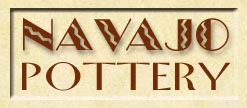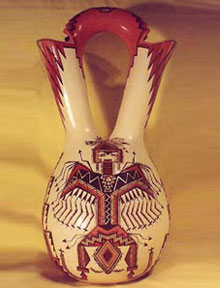|


 ike
other nomadic hunter-gatherers, pottery was not important in the
Navajo culture beyond its production for utilitarian purposes.
By the 1950's Navajo pottery was brown, rough, and shiny, an undecorated
utility ware made by only a few families in the Shonto/Cow Springs
area. Back then pieces were fillet-rim jars or pottery imitations
of pieces normally made in metal, glass, or ceramic: perfectly
serviceable frying pans, coffeepots, and the like. With the arrival
of the trading posts, the Navajos were able to obtain better utensils
made of metal and glass for their own consumption. Less obvious
was the dampening effects of powerful tribal taboos and restrictions
imposed on the potter by the traditionalists and medicine men.
The potter was informed that she should not allow anyone to watch
her at work, that she should not have bad thoughts about others,
and that she should not make pottery if she were menstruating.
The list was long and restrictive in nature with such warnings
as: any pottery cracking or breakage was the consequence of her
transgression; or that the errant potter may suffer illnesses
or accidents. It is little wonder that domestic consumption declined
tremendously. What appears to have preserved any pottery production
at all was the increased demand for ceremonial pieces such as
drum pots. ike
other nomadic hunter-gatherers, pottery was not important in the
Navajo culture beyond its production for utilitarian purposes.
By the 1950's Navajo pottery was brown, rough, and shiny, an undecorated
utility ware made by only a few families in the Shonto/Cow Springs
area. Back then pieces were fillet-rim jars or pottery imitations
of pieces normally made in metal, glass, or ceramic: perfectly
serviceable frying pans, coffeepots, and the like. With the arrival
of the trading posts, the Navajos were able to obtain better utensils
made of metal and glass for their own consumption. Less obvious
was the dampening effects of powerful tribal taboos and restrictions
imposed on the potter by the traditionalists and medicine men.
The potter was informed that she should not allow anyone to watch
her at work, that she should not have bad thoughts about others,
and that she should not make pottery if she were menstruating.
The list was long and restrictive in nature with such warnings
as: any pottery cracking or breakage was the consequence of her
transgression; or that the errant potter may suffer illnesses
or accidents. It is little wonder that domestic consumption declined
tremendously. What appears to have preserved any pottery production
at all was the increased demand for ceremonial pieces such as
drum pots.
 n
spite of such pressures there are a number of excellent contemporary
potters. Betty Manygoats of the Shonto/Crow Springs area pots
both large and small pieces. Alice Williams Cling of Shonto produces
pottery that is simple, yet graceful with fire clouds used to
enhance the looks of her pottery. Since the family is the most
important unit in Navajo society many wife and husband potters
participate in the overall pottery-making procedure. Bertha and
Silas Claw as well as Faye Tso and her husband Emmett create pieces
of simple elegance and beautifully crafted appliqued and incised
motifs. Some potters reflect Pueblo influences including Ida Sahmie,
Nathan Begaye, Christine McHorse, and Lucy Leuppe McKelvey to
cite a few. Lucy Leuppe McKelvey is recognized for her large vessels
displaying elaborate geometric designs and life-form figures,
such as the sacred Yeis and Yei-bi-chais. Though she has been
criticized by some Navajos for using the Yei and Yei-bi-chai figures
on her pottery, she states that her designs are authentic, and
it is her wish that people know the Navajos are very much alive
and growing. One has only to look upon the work of these potters
to understand that a craft that was on the verge of extinction
only forty to fifty years ago is vital, alive, and distinctly
Navajo. n
spite of such pressures there are a number of excellent contemporary
potters. Betty Manygoats of the Shonto/Crow Springs area pots
both large and small pieces. Alice Williams Cling of Shonto produces
pottery that is simple, yet graceful with fire clouds used to
enhance the looks of her pottery. Since the family is the most
important unit in Navajo society many wife and husband potters
participate in the overall pottery-making procedure. Bertha and
Silas Claw as well as Faye Tso and her husband Emmett create pieces
of simple elegance and beautifully crafted appliqued and incised
motifs. Some potters reflect Pueblo influences including Ida Sahmie,
Nathan Begaye, Christine McHorse, and Lucy Leuppe McKelvey to
cite a few. Lucy Leuppe McKelvey is recognized for her large vessels
displaying elaborate geometric designs and life-form figures,
such as the sacred Yeis and Yei-bi-chais. Though she has been
criticized by some Navajos for using the Yei and Yei-bi-chai figures
on her pottery, she states that her designs are authentic, and
it is her wish that people know the Navajos are very much alive
and growing. One has only to look upon the work of these potters
to understand that a craft that was on the verge of extinction
only forty to fifty years ago is vital, alive, and distinctly
Navajo.
|
-
- Item# 0096P
Lucy Leuppe McKelvey, Navajo.
- L. L. McKelvey
is recognized for her large vessels displaying elaborate geometric
designs and life form figures, such as the sacred Yeis and Yei-bi-chaqs.
Her painting style and technique are considered magnificent.
The design of this wedding vase is entitled, "Summer Thunders
and Storm". Top crown of vase shows stair step cut into
pottery and painted in storm pattern of grey-blue, mauve, rust,
and pink colors. The body is decorated with a detailed sandpainting
Thunder Figure with lighting coming from its wings in the same
color pattern as the crown of the piece. Vase shows sparkly
surface for which this artist is known. Won First Prize in the
1992 New Mexico State Fair.
Size: 19" high by 10-1/2"
wide by 8-1/2" diameter.
Price: $6050. Mint Condition.
How to Order

Item# 0101P Laura Leuppe McKelvey, Navajo.
This unique
pot has a large rounded base tapering into a vase like neck.
Around the base of the neck is eleven Kachina masks, thereby,
giving the pot the title of "Masked Gods of the Yei-bi-chi".
Running around the top of the neck is a row of kiva steps
and a double row of kiva steps around the base of the pot
to the mask designs. The basic colors are deep sand red, lighter
sand red, black and cream. The masks also have blue-gray and
brown in some of them. There is a Spirit Line going from top
to bottom on the pot.
Size: 11" high by 14-1/2" diameter.
Price: $7150. Mint Condition.
How to Order
View
More Navajo Pottery
|




